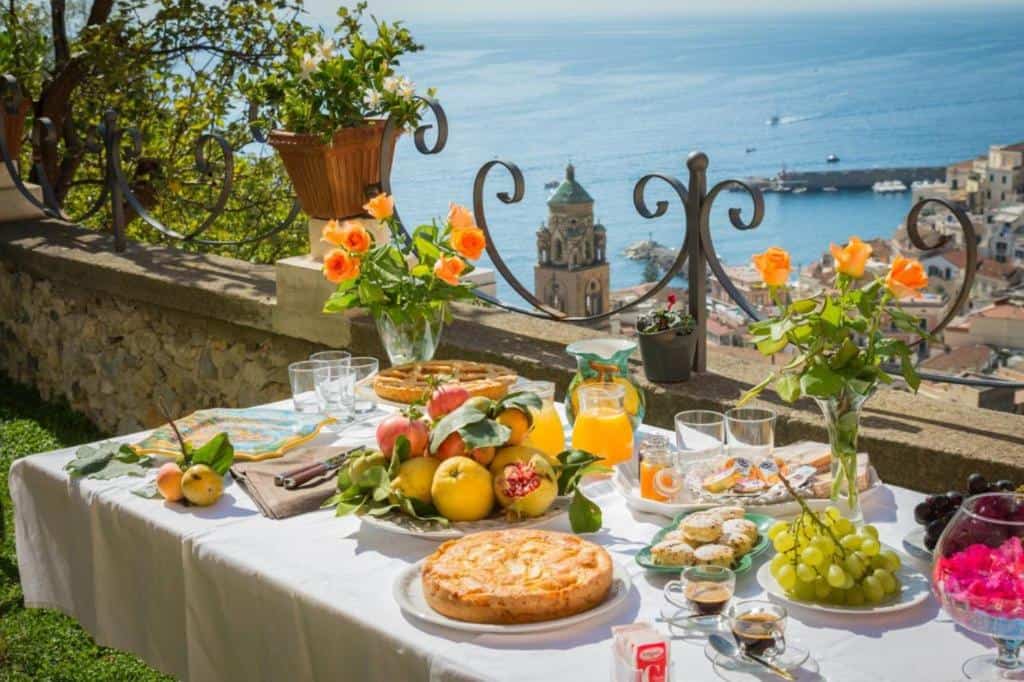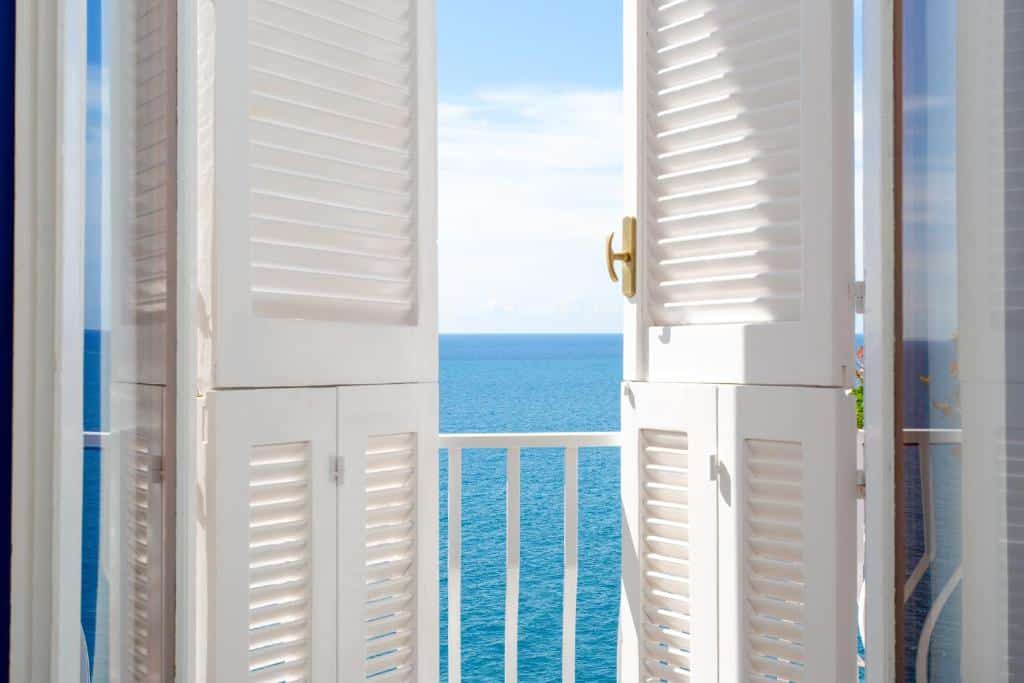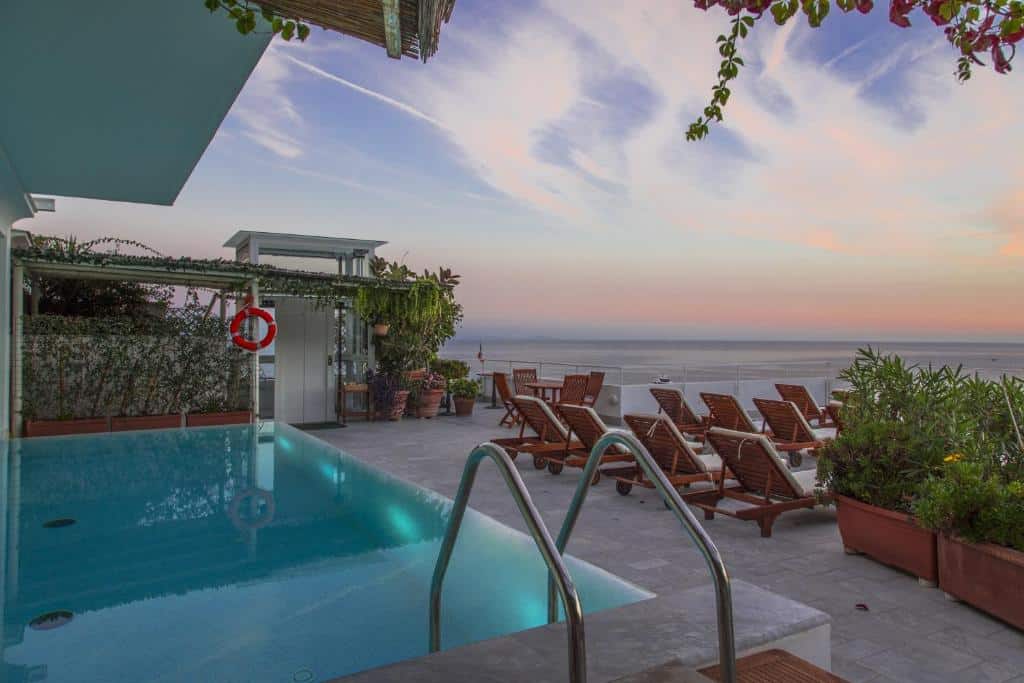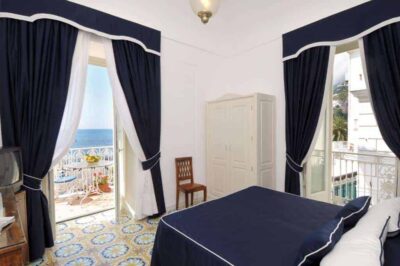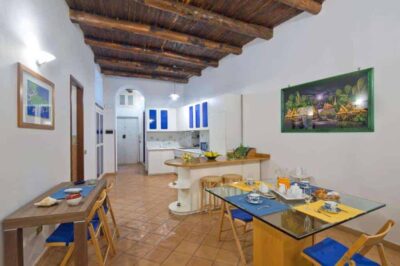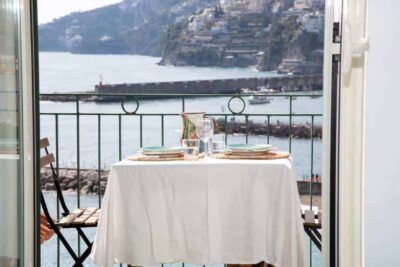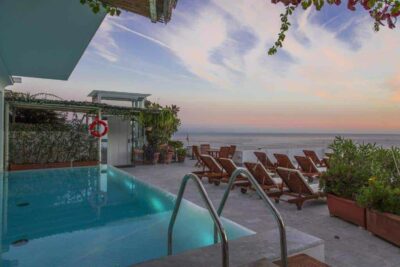“For the people of Amalfi who go to heaven, judgment day will be a day like any another”.
So wrote Renato Fucini, in his travel diary, after visiting the town of Amalfi. Fucini visited Naples and the Amalfi Coast from the first days of April to the end of May 1877: the picturesque villages of our coast were still far from being the coveted and crowded tourist destination they later became.
Of course, since the end of the 19th century something has changed: today, in the peak months, we are far from the tranquility narrated and loved by Fucini: the city center becomes a noisy and colorful riot of life and chaos, a stratification of varied humanity moving spasmodically along the city streets, a bath of joyful and curious crowds entering and leaving stores, restaurants and points of interest.
In short, inevitably something has changed, but Amalfi’s charm remains intact and we will try to tell you about it in the next paragraphs, with the love and passion of always!
Indice dei contenuti
How to Get to Amalfi
The town is not served by a railway line, but on the other hand there are several ways to reach Amalfi.
✅ The most affordable service is public transportation by SITA SUD buses. Amalfi is the terminus of several routes; SITA provides regular runs from Salerno Sorrento and Agerola as well as some direct routes from Naples.
✅ For those arriving from Naples, in the absence of the direct line, it is recommended to reach Salerno and from there change ways to Amalfi.
✅ The town, from April to the end of October, is also served by ferry lines, with departures from the various landing places on the Coast including Positano, Salerno and Capri. At the main junctions you will also find many cars for cab service.
📣 Your road free from queues: book the ferry!
Several car rental companies with driver and without are active, or as a last but not least pleasant option, scooter rental.
If you’re looking for information on how to get around the Amalfi Coast without stress, don’t miss our free e-book: inside you’ll find all the detailed information on means of transportation, parking and tips to minimize travel snags during your stay!
Where to sleep in Amalfi
📣 Looking for a hotel in Amalfi? Here are our recommendations for you!
What to see in Amalfi
A walk through the town
The charm it exudes along with the other towns on the Amalfi Coast allows tourists, couples in love, and people all to experience magical moments.
The plan of Amalfi presents a triangular shape, the base of which is formed by the southern area, by the sea. Here we find the Darsena, a part of the port built after 1900, with masonry constructions, where ships were sheltered. The reference on land, the covered and ancient one, is the Arsenal, an ancient shipyard where the galleys of the Maritime Republic were built, now home to the Museo della Bussola (Compass Museum) e del Ducato Amalfitano and the site of important cultural events. The area towards the east is Towards Atrani, the opposite side goes towards Conca dei Marini and Positano.
On the western side, the district overlooking the state highway and Piazza Flavio Gioia is called Rione Vagliendola, dominated by the church of San Biagio, allows through its flights of stairs to reach the ancient Convento dei Cappuccini, today a luxurious hotel, and near the gallery below the convent, take the Via Maestra dei Villaggi that leads you, through evocative landscapes and smells, to the various hamlets of Amalfi.
Taking the narrow streets on the eastern side you can reach, through narrow and winding ramps and lanes, the monumental cemetery overlooking Amalfi and the center of Atrani, passing through several beautiful and significant places, including the ancient convent of San Francesco with its beautiful cloister, now home to the historic Hotel Luna.
📍The must-see monuments
📍 The Ancient Arsenals of the Republic: this is where your journey of exploration should begin. The famous center-oar galleys destined for trade with The East were built here.
📍 Rione Vagliendola: the historic heart of Amalfi, one of the most characteristic and best preserved historic districts. Here you can admire the old Amalfi aristocratic houses, called “Case turrite”. From here we suggest to reach Piazza dello Spirito Santo and then the Paper Museum, which we will tell you about later in this article.
📍 Amalfi Cathedral: dominates the square from the top of a long flight of steps, now the perfect setting for photos to share on social media! It was built in the 9th century, expanded in 897 and restored in 1203 in the Arab-Norman style. The Gothic atrium is decorated with black-and-white strip marble and divided transversely into two naves by columns. Find more detailed information by reading the full article dedicated to St. Andrew’s Cathedral.
📍 From its portico you can access the Chiostro del Paradiso e Basilica del Crocifisso, Amalfi’s first cathedral now home to the important Diocesan Museum of Amalfi. Inside the Cloister, Arabian influences are visible, evident in the twin columns that frame a peaceful and quiet palm tree garden.
📍 The fountain of St. Andrew the Apostle, located on the eastern side of the square, made in 1760. Its present location dates from the late 1800s when it was moved from its original position at the foot of the Cathedral steps. The artistic ensemble consists of the marble statue of the Apostle at whose feet there are four angels also made of marble; on the two sides are, on the left, a dove, and on the right a sea proteus known as the “Pelican” or “Pulicano” after the nickname of the fisherman who modeled it, and in the center is a mermaid.
📍 The paper museum, housed inside an old paper mill dating back to the 13th century, takes you on a tour of the ancient machinery used in the making of Amalfi’s prized handmade paper, which is still made by hand by skilled Amalfi artisans. The machinery you will see inside the museum is still in working order: during the visit, in fact, it is operated so that visitors can witness with their own eyes the fascinating process of making paper.
📍 Palazzo Morelli: inside this building, currently the seat of the municipal administration, you can see the “Tabula Amalfitana,” the first code of navigation law.
📍 Monumental Cemetery: it can be reached through a long staircase that starts from the back of the Cathedral of St. Andrew and passes through narrow alleys that resemble tunnels and connect the various houses. Approximately 400 steps are required to reach the cemetery, but the effort is rewarded by the beautiful view once you reach your destination.
The present monumental cemetery was once a Benedictine women’s convent, founded around 980 by Duke Mansone I and dedicated to San Lorenzo del Piano.The cemetery’s tuff colonnade, was built in 1816 in place of the abandoned Benedictine monastery. You can also reach the cemetery by taking the elevator that leaves from the entrance of the Luna Rossa Parking gallery in Piazza Municipio.
What to do in Amalfi
📣 Enjoy the best of the Amalfi Coast: we have selected for you the local experiences you really can’t miss!
Trekking and walking
A number of wonderful trekking trails start from Amalfi and where many beautiful Amalfi lemon gardens and workshops that produce limoncello are located. There are three trails that we recommend you consider during your stay in Amalfi.
📍 Valle delle Ferriere
A unique place in the heart of Amalfi. It can be reached in about an hour’s walk from the town center. The walk, of medium difficulty, through pristine woods and streams, leads to the discovery of the ancient mills operated in ancient times by the Canneto stream. The place is unmissable for botany enthusiasts: here, in fact, thanks to the special climatic conditions, Woodwardia radicans, a plant from the pre-glacial period, has been preserved intact.
If you want more information on organizing your excursion to Amalfi, read our article dedicated to Valle delle Ferriere.
📍 The Via Maestra dei Villaggi:
Immediately after the first tunnel, in the direction of Positano, we take a small road that in ancient times was the only link between Amalfi and the villages of Pastena, Lone, Vettica and Tovere, which we will discuss in the following paragraphs. In addition to its historical importance, we recommend this road for strolling among the pretty little houses that seem suspended in time: you will be able to walk through a piece of Amalfi’s history, looking at it from a perspective that becomes more and more fascinating and amazing as you proceed along your route.
📍 The “secret” road from Amalfi to Atrani
If you want to treat yourself to an undemanding walk, we suggest you walk down a few steps and take the road from Via Roberto il Guiscardo to Atrani. In about twenty minutes you reach the small square of Atrani, walking among quiet little houses, away from the chaos that usually characterizes Amalfi and enjoying views you would not expect. Unmissable, especially in the early evening.
Experiences you can only do on the Amalfi Coast
In addition to trekking and beautiful walks with breathtaking views, you could go to discover our sfusato amalfitano, the authentic pride of our land!
Sfusato, what a passion!
Our native lemon tree is the true symbol of our land: it represents, in fact, the sacrifice and dedication of our ancestors, who literally wrested the land from the mountain, making it fertile and cultivable, through a complex and laborious work of building engineering.
This is why the conformation of our territory appears so peculiar to the eyes of the traveler visiting it for the first time: these green and yellow terraces, resembling giant steps descending to the sea, have a beautiful story to tell! Take advantage of your stay in Amalfi to get to know the intimate and secret essence of our places: invest a few hours of your day to visit a characteristic lemon grove, watch up close the processing stages of our sfusato amalfitano, and meet in person our “flying farmers,” who work literally suspended between sky and sea.
If you want to find out more about our lemon groves and this product that represents us so much, read our full article dedicated to sfusato amalfitano.
Traditional cuisine to learn…
Another way to get in touch with local essence is definitely a dive into the flavors and delicious raw materials of the area. If you are a true food lover and when you travel you want to go in search of typical dishes, here you are spoiled for choice, among restaurants and typical places. An additional step in the discovery of our cuisine could be to touch the local recipes by choosing a cooking class of typical cuisine, perhaps in a quiet location, surrounded by greenery.
…and to taste
If, on the other hand, you are more passionate about the moments when you sit down at the table and eat, we suggest you organize a boat trip and stop at one of the restaurants by the sea that can be reached only by private boat: we are not recommending the classic tourist restaurants, but delicious little family-run places that make tasty dishes every day with fresh fish and local ingredients.
The Villages of Amalfi
We’ve mentioned to you La via Maestra dei Villaggi, so we can’t leave out some information about Amalfi’s villages.
📍 Pogerola: Amalfi’s most populous hamlet, along with Tovere, is the only hamlet in Amalfi that is not washed by the sea. The hamlet of Pogerola appears in maps only in the 10th century, indicated by the Castrum Pigellule, a castle that stood on the back of the western hill of Amalfi, some vestiges of which are still visible. Places of interest are: the sanctuary of the Madonna delle Grazie, in the square of Pogerola, not far away the parish of S. Marina, the sanctuary of S. Maria dei Fuonti reachable by a short trekking path through the ancient Porta del Gaudio, the walk to the Castle.
📍 Lone: less than 1 km from Amalfi, it can be reached from the state highway and the main village road and is characterized by beautiful terraced gardens and the church of S. Maria Vergine with its ancient bell tower dating from 1200.
📍 Pastena: a little more than 1 km from Amalfi, reachable throught the Via Maestra dei Villaggi and by the driveway to Pogerola, it enjoys one of the best views of Amalfi, particularly from the church of the Madonna Assunta, built in the 14th century with typical pointed cross vaults, and dominated by the unique bell tower with its sea-green tiled roof.
📍 Vettica: about 3 km from the center of Amalfi, can be reached via the state road, and is on the border with the municipality of Conca dei Marini, not to be confused with Vettica Maggiore, in the municipality of Praiano. Vettica Minore is projected onto the sea, with splendid little beaches including the renowned S. Croce where, among the many marine rock formations, you will find the striking natural arch known as “Arco degli innamorati” (Lovers’ ark).
In the small beaches and on the cliffs there is no shortage of some excellent restaurants that will be able to enhance and make you appreciate the spectacle of the panorama to the fullest, through the smells and flavors of typical seafood dishes.
📍 Tovere: about 4 km from Amalfi along the road leading to Furore and Agerola, was founded in the 13th century by some sailors and peasants under the name of Tobulum. It enjoys a splendid panorama over which the bell tower of the church of St. Peter the Apostle, known as St. Anne, built in the 13th century in Arab-Norman style, stands out.
Beaches not to be missed in Amalfi
Having exhausted the cultural part, we turn in this section to those who choose the Amalfi Coast as their summer vacation destination.
If you are a sea lover, if you truly love diving and spending days on the boat, if the only thing you desire is a golden tan and long hours of relaxation on the beach, we advise you to avoid the central beaches, which during the months of July and August can be crowded.
If you go in search of more tranquility, consider these beaches:
✅ Duoglio: 170-meter-long pebble beach, which is reached by a staircase of no less than 465 steps. The beach is also served by sea service, offered by some local cooperatives. This beach is served by bathing establishments, including one with a restaurant.
✅ Santa Croce beach: you can reach it by the stairway from the state road (about km 27 – 364 steps in total), or by private boat (as we already suggested, ask at the harbor beach). On this beach you find the remains of a small chapel dedicated to the Holy Cross, hence the name of the beach “Santa Croce”. The beach is served by bathing establishments and a restaurant. Ideal for a full day immersion!
✅ Le Marinelle: Ideal beach for those seeking more privacy. It is about 300 meters from Santa Croce beach, but unlike the previous one, it can only be reached by sea by private boat or canoe from Santa Croce beach. It is not served by bathing facilities, which means more peace and relaxation.
Must-see events in Amalfi
✅ Among the must-see events in Amalfi, it is impossible not to mention the Historical Regatta of the Ancient Maritime Republics. Every 4 years, the town hosts this heartfelt and important competition, embellished by the costume parade and collateral events and exhibitions.
✅ Another noteworthy event is definitely the Byzantine New Year, on August 30 and September 1 each year. This event consists of a parade in which participants wear costumes from the Historical Regatta. In particular, September 1 takes on special historical connotations, as this date in the Byzantine world coincided with the beginning of the fiscal and agricultural year. The Byzantine New Year is usually enriched by musical events, lectures, cultural events and entertainment, with the aim of bringing back the city’s medieval traditions, spirit and culture.
✅ Last but not least: the festival dedicated to St. Andrew, the city’s patron saint. The feast, which is celebrated on June 27 and November 30, is very heartfelt and includes a procession through the streets of the city, involving the entire population of Amalfi. The procession ends with a very fascinating rite: the running of the Saint down the steps of the cathedral: it is a solemn moment, in which the faithful, dressed in red, run carrying the statue of St. Andrew on their shoulders, cheered on by the crowd of faithful. Upon reaching the top of the stairs, the emotion of the faithful melts into heartfelt and warm applause.
Why choose Amalfi as a travel destination?
The town, unmistakable in its appearance and picturesque in its location, clings to the rocky overhangs of the Lattari Mountains by penetrating into the narrow Valle dei Mulini with streets, little stairways and alleys that unravel from the hillside and wedge between homes and beautiful terraced gardens.
Every corner, every alley and every little square opens up unusual perspectives and silent, picturesque views: this is the scenery that has enchanted generations of travelers, the romantic landscape par excellence, where the gentleness of the climate and the beauty of villas-houses leaning against each other-are combined with the rugged and seemingly inhospitable nature of mountains overlooking the sea. Its establishment as a Maritime Republic and its intense relations with the Arab and Byzantine world made it a “rich and opulent city” throughout the Mediterranean basin.
📣 Choose Amalfi as a starting point for your trip if:
🔹 you are looking for a convenient destination that allows you to travel easily to all the other towns on the Coast. Please note that all connections, by sea and by road, to the other countries on the Coast depart from Amalfi;
🔹 you travel with children: in addition to the previous point, remember that Amalfi has a conformation that allows you to move easily even with a stroller. In the case of traveling with offspring in tow, we recommend choosing a more central facility, to have easier access to services and to move with greater agility within the town.
If, on the other hand, you are planning a one-day stop in Amalfi or a romantic getaway, we recommend reading our article in which we give you many useful tips for planning a day trip to Amalfi.
The best time to visit Amalfi
We definitely recommend that you choose the fall or spring period. In the summer months, particularly from June to August, the town is literally taken by storm by travelers and tourists. This results in packed venues, crowded tourist attractions and streets, difficulty finding parking and getting around by bus, which are, in turn, so crowded that you run the risk of not being able to get on board, for obvious safety reasons.
In addition, the high temperatures of the summer period can create discomfort, especially if you are traveling with children or have special medical conditions.
The fall and spring periods, in addition to providing a more pleasant climate, offer the great advantage of enjoying the city without having to scramble through the crowds, with greater tranquility and slowness. On weekdays, the city offers unforgettable emotions.
3 Fun facts about Amalfi
✅ The permanent nativity scene in a fountain with an unusual name Going up from Piazza Duomo and reaching Via Pietro Capuano, while you are immersed in the chaos of the city bustle, you can admire the permanent nativity set up in the fountain named “De Cape e’ ciucci.” (literally “Donkeys’ head).
The nativity scene can be visited all year round, but it is embellished during the Christmas holidays. It is a truly curious and special spot to photograph.
✅ A timeless dish born in Amalfi Scialatielli was supposedly born right here in the 1960s at the hands of Enrico Cosentino, then a novice cook at La Caravella restaurant in Amalfi. The dish, seasoned with cuttlefish, mussels, shellfish and crustaceans, earned the chef the Entremetier prize in the 1978 international cooking competition. In short, if you’re looking for a truly typical dish to try during your visit to the town, you’ve just found it.
✅ A poet in love with Amalfi The poet Salvatore Quasimodo was in love with Amalfi. He arrived there for the first time on January 20, 1966. During his stay in Amalfi he wrote some wonderful poems, such as “Oboe Sommerso,” “Giorno dopo Giorno,” and “La Terra Impareggiabile.”
He returned there several times and died there on June 4, 1968, when he suffered a stroke. Of his love for the town, the plaque in his memory remains visible in Amalfi, where his words read, “Here is the garden we always and futilely seek after the perfect places of childhood. A memory that happens tangible above the abysses of the sea, suspended on the leaves of orange and cedar trees sumptuoushanging gardens of convents.”
Insights: Notes on the History of Amalfi
In this setting, history and legend overlap. Legend has it that Hercules fell in love with the nymph Amalfi, who died prematurely, and whom Hercules wanted to bury in the most beautiful place in the world where, to immortalize her, he founded a city to which he wanted to give precisely the name Amalfi.
According to the Chronicon Amalphitanum, on the other hand, Amalfi was founded in the fourth century A.D., at the time of Emperor Constantine, by a group of Roman families who, having set out for Constantinople, were surprised by a violent storm in the Ionian Sea and forced to take refuge near Ragusa in Dalmatia.
After a brief stop they resumed sailing and between Palinuro and Pisciotta they founded a village which, from the name of the river that flowed there, they called Melfi; later threatened by frequent Vandal raids, they thought of taking shelter further north, in the present coast, where they discovered a well-protected place rich in water and decided to settle there permanently.
After an initial settlement at Scala, they founded two cities in the valleys below to which they gave the name Amalphia in memory of the abandoned Lucanian town and Atranum from ater = dark because of the rocks that loomed over the narrow valley. Another hypothesis has it that the name Amalfi derives from the surname of a Roman gens of the first century AD, the Amarfia. In fact, the remains of the Roman Villa found near the Cathedral, which constitute the earliest major evidence of the settlement of Amalfi, are dated to the 1st century AD.
In the 6th century, at the time of the Greco-Gothic war, Amalfi constituted the extreme southern offshoot of the Byzantine Duchy of Naples, in the guise of a Castrum, a fortress village. The absence of a strong central power (the capital was the distant Byzantium) left ample room for the administrative and economic emancipation of Amalfi, which in 596 was already an episcopal seat.
Freedom was always won at great cost: in 836 Sicard, Lombard duke of Benevento, thanks to the treachery of some local families, conquered the city by sacking it and deporting most of the population to Salerno. As a result of internal divisions within the Lombard court, the Amalfitans three years later managed to reorganize and rebel, inflicting a crushing defeat on the Lombards, killing Duke Sicard and freeing the Amalfitan hostages still held captive in Salerno. On September 1, 839, the Independence of Amalfi was then declared, thus constituting itself as an autonomous and sovereign republic.
From that time and for the next three centuries, the Amalfi people were ruled by an authority that was almost always their direct expression with titles that changed over time: comites, prefects, judges or dukes; the rulers implemented a shrewd policy of alliances to safeguard the commercial interests and autonomy of the Republic. On some occasions, Amalfi also allied with the Saracens, but then did not hesitate to fight them, until their final expulsion from Amalfi’s territory in 915.
Its greatness dates back to the 10th and 11th centuries when Amalfi established itself in both the political and commercial spheres so much so that its ships began to ply the seas and go farther and farther in search of new markets. From its famous arsenals came gigantic 116-oared galleys, the largest of the time, and spices, perfumes, silks and precious carpets passed through its port.
It was the first independent Maritime Republic and extended its jurisdiction not only over the coastal territory from Cetara to Positano with the islands of Li Galli and Capri, but also over the interior, over the towns of Scala, Tramonti, Agerola, Lettere, Piemonte and Gragnano; it was able to mint currency and have its own constitution.
The whole territory was protected by a defense system set up unitarily: a castle was built at Tramonti for the protection of the Chiunzi pass road and four castles at Lettere, Gragnano, Pino and Pimonte for protection of the access road from Agevola; the defense of the city on the coast was particularly taken care of, according to a system considered impregnable for the time. The castle of Maiori and its walls represented the main defense against the Lombards from Salerno; the castles of Minori, Agerola, Ravello and Scala together with the Towers of Pontone ensured the security of Amalfi, which in turn was surrounded by walls.
In this context of efficiency and organization, the Amalfitans were the first to endow themselves with a maritime code, the Tabula Amalphitana, a set of laws, rules and customs of 66 chapters that regulated relations between the members of crews and all matters of maritime commerce; this code was universally respected throughout the Mediterranean basin.
Its autonomy and splendor lasted until 1135, when the city was sacked by the former allies of Pisa, the newly emerging maritime power, but previously it had also suffered a severe defeat by Robert Guiscard and then Roger the Norman; the tidal wave of 1343 and the terrible plague of 1348 hastened its decline.
Amalfi then lost its commercial importance, its independence and its status as a maritime republic. Amalfi and all the other towns on the Coast that had been splendid localities rich in history to be read in the sumptuous palaces adorned with frescoes, churches, marble, columns and fountains, were on their way to becoming modest towns that, deprived of the wealth that came from trade on the sea, reverted to the traditional economy that came from fishing, crafts and agriculture.
It was not until the end of the 19th century, with the rise of the tourism, that Amalfi was discovered as a place to stay and study by numerous foreign travelers: thus it was that the landscapes, monuments, and scenes of daily life became a source of inspiration for writers, painters and artists from all over Europe.
It is since the first decades of the 20th century, however, that the appeal exerted by the scenic beauty of the places and the suggestions deriving from their history-rich past have gradually attracted the attention of an increasing number of admirers, restoring Amalfi and its coast to a leading position in the international arena.


